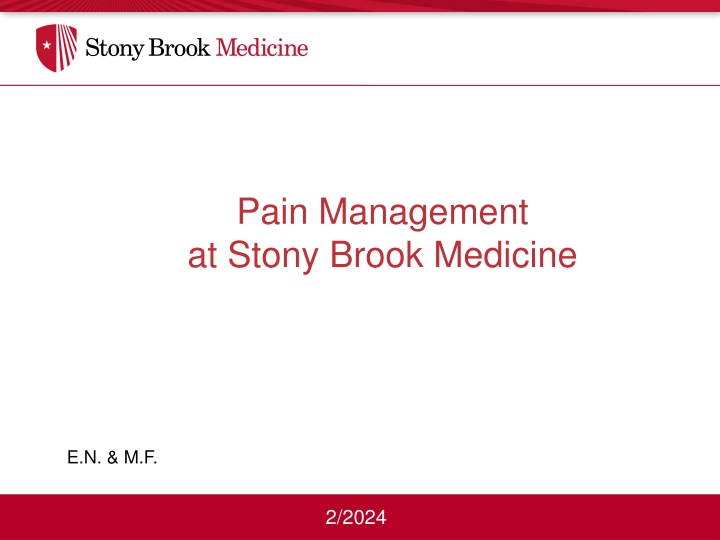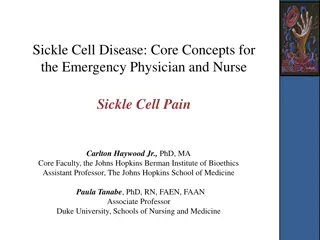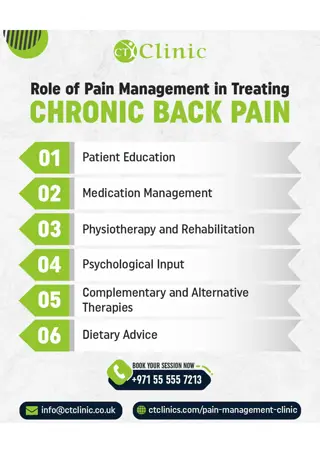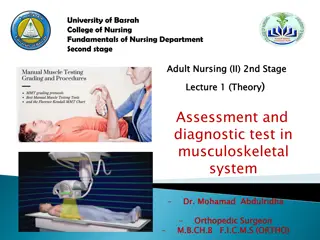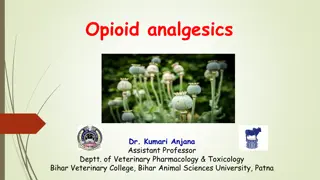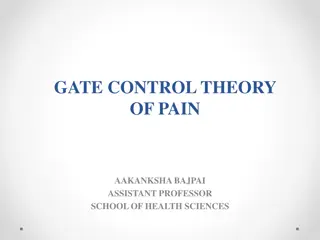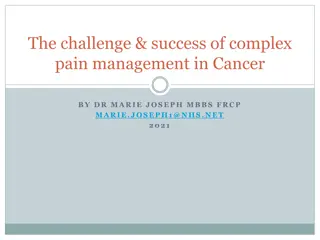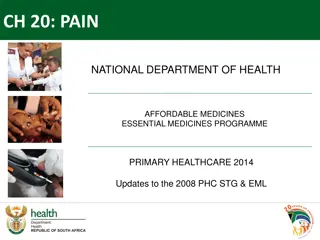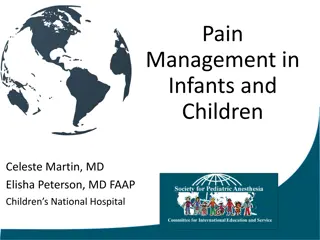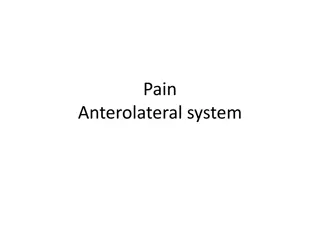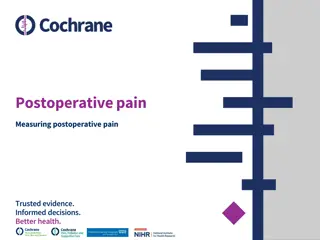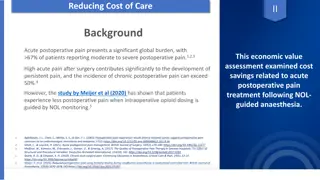Pain Management at Stony Brook Medicine
"Explore pain assessment tools, determinants, and structured policies for effective pain management at Stony Brook Medicine. Understand the importance of patient self-reporting and behavioral assessments in determining pain levels. Learn about the different aspects of pain assessment and re-assessment protocols to ensure optimal care and treatment outcomes."
Download Presentation

Please find below an Image/Link to download the presentation.
The content on the website is provided AS IS for your information and personal use only. It may not be sold, licensed, or shared on other websites without obtaining consent from the author.If you encounter any issues during the download, it is possible that the publisher has removed the file from their server.
You are allowed to download the files provided on this website for personal or commercial use, subject to the condition that they are used lawfully. All files are the property of their respective owners.
The content on the website is provided AS IS for your information and personal use only. It may not be sold, licensed, or shared on other websites without obtaining consent from the author.
E N D
Presentation Transcript
Pain Management at Stony Brook Medicine E.N. & M.F. 2/2024
Objectives To review pain assessment. To review pain management options. To review TJC Patient preference standard, CMS Core Measure 506, NYS Annual Opioid Antagonist prescription Requirement, PMP To review resources available at Stony Brook.
PAIN MANAGEMENT POLICY All patients must have effective pain management. Patient self report of pain must be source of assessment whenever possible. Patient s acceptable level of pain must guide treatment. Pain is assessed using a population- specific standardized assessment scale. PC 0039 Pain Management
WHAT IS PAIN? An unpleasant sensory and emotional experience associated with actual or potential tissue damage, or described in terms of such damage. International Association for the Study of Pain (Merskey, 1979) Pain is always subjective. The patient s self-report of pain is the single most reliable indicator of pain. 2/2024
DETERMINATION OF PAIN If the patient is unable to self report, appropriate behavioral pain assessment tools should be utilized: N-PASS: NICU FLACC : pediatrics, Newborn nursery CPOT: intubated/sedated patients and TBI PAIN-AD: Geriatrics Behavioral Pain Assessment Tools
DETERMINANTS OF PAIN The tools look at: Observable behaviors (facial expressions, body movements, crying) physiological measures (heart rate and blood pressure).
PAIN ASSESSMENT Initial Pain Assessment should include: Location(s) , Intensity , Sensory quality , Alleviating and aggravating factors Any new onset of pain requires a new comprehensive pain assessment. Assume Pain is Present (APP): Term used to document pain in a patient who cannot self report pain. The patient undergoing a procedure would be assumed to have pain 2/2024
PAIN RE-ASSESSMENT Pain Re-assessment: Every shift minimally-pain score, sedation score, and respiratory rate/assessment. IV: within 15-30 minutes of administration of dose. PO/IM/SC: within 1 hour of administration of dose 2/2024
ACUTE PAIN Acute pain presents most often with a clear cause, relatively brief in duration and subsides as healing takes place. Acute pain is often accompanied by observable, objective signs of pain: increased pulse rate increased blood pressure Non-verbal signs and symptoms such as facial expressions and tense muscles. 2/2024
COMMON ACUTE PAIN CONDITIONS Acute Postoperative Pain Pain due to trauma Sickle cell painful crisis Acute pancreatitis Acute on top of chronic like exacerbation of chronic back pain 2/2024
CHRONICPAIN Pain that is persistent and recurrent. When pain persists, it serves no useful purpose and may dramatically decrease the quality of life and function. Chronic pain rarely has any observable or behavioral signs, although persons may appear anxious or depressed. 2/2024
CANCER PAIN Pain that is associated with cancer or cancer treatment. May be attributed to: Tumor location Chemotherapy Radiation therapy Surgical treatment 2/2024
RESPONSIBLE OPIOID PRESCRIBING There is a national epidemic occurring involving the misuse, abuse, and diversion of prescription opioids. The majority of these medications enter circulation through legitimate prescriptions by physicians from all specialties. Prescribers must be aware that their opioid prescription could potentially end up being used for reasons not prescribed (sold, snorted, traded). 2/2024
CONCERNS REGARDING INCREASING OVERDOSE DEATHS 1999-2021
CMS CORE MEASURE The US government declared the opioid epidemic a public health emergency in 2017. In 2023, 108,000 died from an opioid overdose. About 20% of deaths are from prescription drug abuse. CMS has identified an increased risk of overdose when patients are discharged with two opioids or an opioid and a benzodiazepine and subsequently are monitoring discharge orders for two opioids or an opioid and a benzodiazepine. (Exception cancer/palliative patients)CMS Core Measure 506 2/2024
PAIN MANAGEMENT APPROACH Should be interdisciplinary and multimodal. Care is individualized GOAL OF PAIN MANAGEMENT: MANAGING PATIENT EXPECTATIONS 1. Maintain patient safety 2. Optimize patient function 3. Decrease pain score 2/2024
RISK FACTORS FOR OPIOID USE Age > 60 Pre-existing Respiratory disorders: Sleep apnea and COPD Pre-existing cardiac disease, especially chronic heart failure. Opioid Na ve patients. Concurrent use of sedatives or opioids. Thoracic or surgical incisions may impair breathing Risk Factors
MULTIMODAL ANALGESIA This term describes the use of multiple modalities to provide pain relief with various parts of the pain pathway targeted. Decreased dependence on single modality agents decrease the risk of side effects. 2/2024
PAIN MANAGEMENT OPTIONS Treatment options: Pain Management Nerve Blocks Pharmacological Physical Heat and cold Acupuncture TENs Relaxation techniques 2/2024
TREATMENT OPTIONS Pharmacological: Pharmacological Opioids Acetaminophen NSAIDs 2/2024
PHARMACOLOGIC MANAGEMENT Principles of the WHO pain management: By the clock By the mouth By the ladder
PHARMACOLOGICAL MANAGEMENT Nonopioid medications ( Acetaminophen and NSAIDs ) should be: Prescribed first unless contraindicated Around the clock. Opioids are prescribed as needed and only if the pain is severe. 2/2024
NON-STEROIDAL ANTI-INFLAMMATORY DRUGS NSAIDS: Non-Steroidal Anti-inflammatory Drugs NSAIDS Non-Selective Selective COX1 & COX2 Cox2 Only Ibuprofen Celecoxib Toradol ( Ketorolac) 2/2024
NSAIDS Nonsteroidal Anti-inflammatory drugs can have significant opioid-sparing effects that can be close to 50%. Contraindications: History of peptic ulcers and gastrointestinal bleeding, celecoxib may be used with caution. Renal impairment Pregnancy Severe coronary heart disease : use with caution, especially the celecoxib. 2/2024
NSAIDS/ ACETAMINOPHEN Acetaminophen is available in the oral and IV form (Ofirmev). NSAIDS are mostly oral. Intravenous NSAIDs : Ketorolac ( Toradol ) and Ibuprofen (Caldolor). 2/2024
ADJUVANT ANALGESICS (CO-ANALGESICS) Medications were initially developed for a primary indication other than pain. Secondary effects of analgesia, e.g. Antidepressants : e.g. Amitriptyline, Duloxetine Anticonvulsants: Gabapentin Steroids Muscle relaxants 2/2024
PATIENT PREFERENCE TJC Standard: Patient Preference The patient can choose a lower dose, lower potency(Tylenol instead of an opioid) or less invasive route of medication for pain. In order to meet the standard: 1-The prescriber must have a patient preference order prescribed. It is listed under the medication orders. The patient preference order can be used whenever there are pain medications ordered for different levels of pain. 2-The RN needs to document on the MAR under comments that the medication of lower dose, potency or less invasive route was given due to patient preference. 3-This standard does not allow for patient choice in higher doses or more invasive route of medication for pain. 2/2024
OPIOID SPARING PROCEDURES 2/2024
NERVEBLOCKS These blocks are used for acute postoperative pain or pain due to trauma. The acute pain service anesthesiologist provides them. They can be placed in almost any region of the body. Nerve catheters can be placed to prolong the nerve block and analgesia if the patient stays in the hospital. 2/2024
PATIENT EDUCATION TJC requires patient education on: Pain Management plan for discharge Safe use of opioids-Taking medications as prescribed, no sharing of medications, avoid driving or activities requiring attention when taking opioids, educate on use of naloxone if discharging home with it Storage and disposal of opioids-Store preferably in a lock box. Proper disposal of fentanyl patches. Take back program to dispose of unused opioids. 2/2024
RESPONSIBLE OPIOID PRESCRIBING- IDENTIFYING RISK OF SUBSTANCE ABUSE Doctor Shopping: Using more than one doctor to obtain opioids Prevent by checking databases 1. External medication history on EMR 2. New York State Prescription Drug Monitoring System NYS requires all providers who prescribe opioids to check the PMP prior to ordering opioids. Link found on The Pulse, under Resources : I-STOP NYSPMP (Prescription Monitoring Program / Registry) To sign up for NYS PMP: https://commerce.health.state.ny.us/hcsportal/appmanager/hcs/home 1-866-529-1890 (M-F 8-4:45pm) 2/2024
RESPONSIBLE OPIOID PRESCRIBING NYS Public Health Law section 3309(7) requires prescribers to prescribe an opioid antagonist with the first opioid prescription each year in patients: History of substance use disorder High dose, cumulative prescriptions of 90 morphine equivalents or higher per day Concurrent use of opioids and benzodiazepine or sedative hypnotics
RESOURCES ACUTE PAIN SERVICE Provides 7 days per week, 24-hour consultative services every day of the year. Manages IV PCA, epidural catheters, nerve block catheters, and ketamine infusions for pain. Page Acute Pain Beeper( Pain PCA) for assistance. 2/2024
ACUTE PAIN SERVICE The Acute Pain Service must be notified for: Patients who report an indwelling device for pain management (e.g. , intrathecal pain pump or spinal cord stimulator). Any pre-surgical patient who is followed by an outpatient pain clinic. Any pre-surgical patient who is opioid tolerant: receiving long-acting/controlled-release narcotics Any pre-surgical patient who reports or tests positive for illicit drug use. 2/2024
SBUMC CENTER FOR PAIN MANAGEMENT The Chronic Pain Center is located in the Center for Pain Management at Smithhaven Mall Call 638 PAIN to make an appointment for an outpatient consultation Treatments offered: Chronic non-urgent cases, e.g., chronic back pain, phantom pain, chronic persistent pain. Treatment is mainly interventional. Epidural steroids, facet injection, stellate ganglion block. Refill of intrathecal pumps, follow-up of spinal cord stimulators. 2/2024
PSYCHIATRY Call 4-3408 for a consult. Contact for assistance: With opioid withdrawal (IVDA, methadone) To start medication-assisted therapy (MAT): suboxone and methadone. Social work can assist with setting up referrals to outside methadone clinics or suboxone providers. Can assist with the control of anxiety or depression, which impacts controlling pain. 2/2024
References /policy PC 0039 Pain Management Policy The Joint Commission. R3 Report/ Requirement, Rationale, Reference: A complimentary publication of the Joint Commission-Pain assessment and management standards for critical access hospitals. NYS Annual opioid antagonist Prescription Requirement- Effective June 2022 CMS Core Measure 506: Safe Use of Opioids 2/2024
